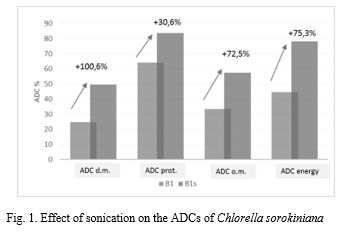EFFECT OF SONICATION ON THE NUTRIENT DIGESTIBILITY OF Chlorella sorokiniana IN RAINBOW TROUT Oncorhynchus mykiss
Introduction
Despite the growing interest in microalgae as sustainable sources of nutrients in complete feeds and recent findings indicating their good potential as a bulk feedstuff for formulated aquafeeds, their dietary inclusion, even at low level, often implies declining nutrient and energy availability in carnivorous fish species (Sorensen et al., 2016; Kousulaki et al., 2015; Tibaldi et al., 2015; Tulli et al., 2012; Burr et al., 2011). A possible adverse role of microalgae cell wall structure and composition on nutrient availability has been hypothesized by different authors. This study was carried out to test sonication as a possible post production cell wall disruption technique to increase the digestibility of Chlorella sorokiniana freeze dried biomass in rainbow trout.
Material and methods
Chlorella sorokiniana (IAM 212 strain from the Culture Collection of Fotosintetica & Microbiologica S.r.l.) biomass (400 g dry weight) was cultivated at the Laboratory for the Ecosystem Studies of CNR, Sesto Fiorentino (FI, Italy) in "Green Wall Panel" photobioreactors (Tredici et al., 2011) under standardized cultivation conditions. An aliquote of the biomass was subjected to sonication (20 kHz and 130 W) (MicrosonTM XL2000, Misonic Inc., Farmingdale, NY, USA) for 30 min at < 25°C. From a basal reference diet mash (CTR) including Chilean fishmeal, wheat gluten, wheat middlings, solvent extracted soybean meal, fish and rapeseed oils, two test diets were obtained including finely ground intact (B1) and sonicated (B1s) C. sorokiniana dried biomass at a 12:88 w:w microalgae to reference diet ratio. All diets were added with acid insoluble ash (1.0 %) as an inert marker before being extruded and dried into 3 mm pellets at the facilities of CUSA - University of Udine, Italy.
The apparent digestibility coefficients (ADCs) of dry matter, protein, organic matter and energy for reference and test diets were estimated in vivo with juvenile rainbow trout using 9 units of three 75-L tanks, each stocked with 12 fish (52.4±1.5 g), fitted with a settling column for faecal collection. Each diet, offered to visual satiety in two daily meals, was evaluated over three independent 10-day faecal collection periods preceded by 7 days adaptation to the new diet according to a complete Latin square design. Freeze-dried faecal samples were analysed for dry matter, ash, nitrogen, lipid, energy and acid insoluble ash according to official analytical methods. ADCs were calculated by difference relative to those measured with the reference diet according to Cho & Slinger (1979).
Results
The intact C. sorokiniana (B1) resulted in ADC of 24.7±3.58 % for dry matter, 64.2±2.1 % for protein, 33.4±4.3 % for organic matter and 44.5±3.5 for energy. Sonicated Chlorella (B1s) resulted in ADC of 49.6±3.7 % for dry matter, 83.9±1.5 % for protein, 57.5±5.4 % for organic matter and 78.0±3.8 gross energy. As shown in Figure 1, the apparent digestibility coefficients of all nutrients and energy significantly improved after sonication (P<0.05; P<0.001).
Discussion
The present results provide the first estimate of the effect of sonication on the apparent digestibility coefficients of a green microalgae, C. sorokiniana, for a fish species. The sonication treatment applied to the microalgae biomass significantly improved the availability of nutrients and energy compared to the intact Chlorella. Likewise was reported in rats (Janczyk et al., 2007), also in rainbow trout the physical treatment applied to the microalgae seems to affect the microalgae cell wall, letting the nutrients become more bioavailable for animal digestion. The algae nutritional potential was largely enhanced and resulted in nutrient digestibility estimates comparable to conventional plant protein rich ingredients, which use are already consolidated in trout feed formulations.
These results open new perspectives for the utilization of Chlorella spp. biomass as alternative ingredient in dietary formulations for carnivorous fish species and the exploitation of its biological properties in aquafeeds. They may also provide clues for finding physical or enzymatic cell wall rupture treatments for green microalgae more compatible with industrial mass production processes.
Aknowledgements
This study was partially supported by MARINALGAE4aqua "Improving bio-utilisation of marine algae as sustainable feed ingredients to increase efficiency and quality of aquaculture production" ERA-NET COFASP/004/2015.
References
Cho C.Y. & Slinger, S.J. (1979) Apparent digestibility measurement in feedstuffs for rainbow trout. In: Haver J.E., Tiew K. (Eds.), Finfish Nutrition and Fishfeed Technology, Vol. II. Heenemann, Berlin, pp. 239-247.
Janczyk P., Franke H., Souffrant W.B. (2007) Nutritional value of Chlorella vulgaris: Effects of ultrasonication and electroporation on digestibility in rats. Animal Feed Science and Technology 132: 163-169.
Sørensen M., G. M. Berge, K. I. Reitanc, B. Ruyter (2016) Microalga Phaeodactylum tricornutum in feed for Atlantic salmon (Salmo salar) -Effect on nutrient digestibility, growth and utilization of feed. Aquaculture, 460(1): 116-123.
Tibaldi E., Chini Zittelli G., Parisi G., Bruno M., Giorgi G., Tulli F., Venturini S., Tredici M.R., Poli B.M. (2015) Growth performance and quality traits of European sea bass (D. labrax) fed diets including increasing levels of freeze-dried Isochrysis sp. (T-ISO) biomass as a source of protein and n-3 long chain PUFA in partial substitution of fish derivatives. Aquaculture, 440: 60-68.
Tredici M.R., Rodolfi L., Sampietro G., Bassi N. (2011) Low-cost photobioreactor for microalgae cultivation. Patent WO 2011/013104 A1
Tulli F., Chini Zittelli G., Giorgi G., Poli B. M., Tibaldi E. & Tredici M. R. (2012) Effect of the Inclusion of Dried Tetraselmis suecica on Growth, Feed Utilization, and Fillet Composition of European Sea Bass Juveniles Fed Organic Diets. Journal of Aquatic Food Product Technology, 21 (3): 188-197.
